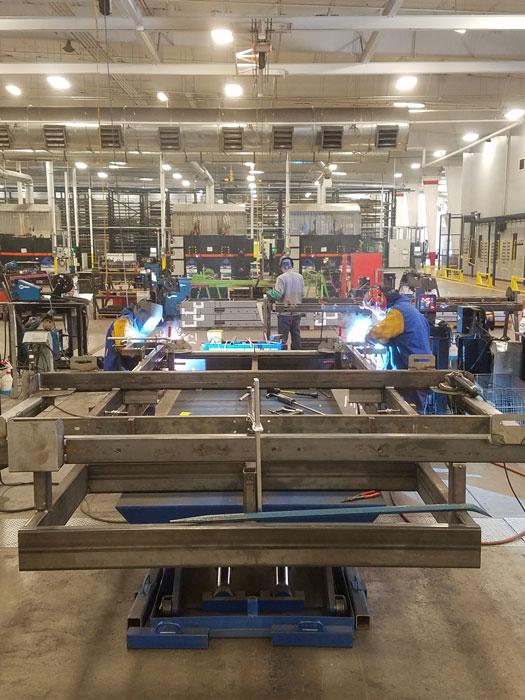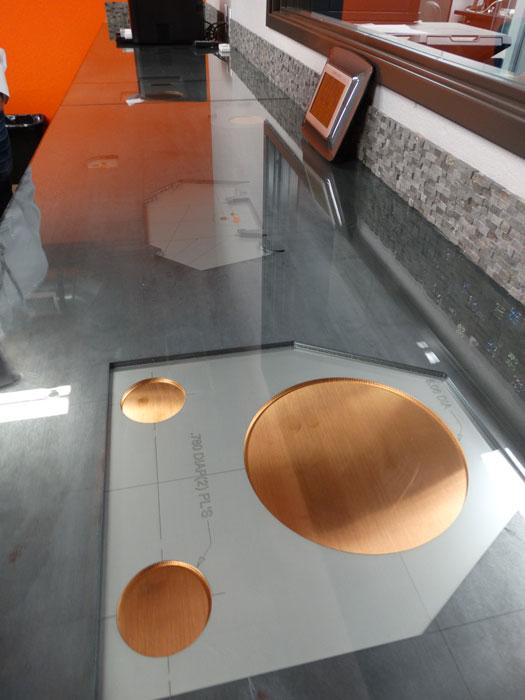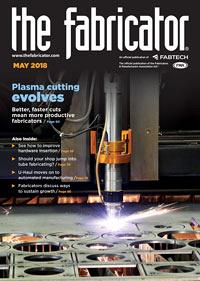Senior Editor
- FMA
- The Fabricator
- FABTECH
- Canadian Metalworking
Categories
- Additive Manufacturing
- Aluminum Welding
- Arc Welding
- Assembly and Joining
- Automation and Robotics
- Bending and Forming
- Consumables
- Cutting and Weld Prep
- Electric Vehicles
- En Español
- Finishing
- Hydroforming
- Laser Cutting
- Laser Welding
- Machining
- Manufacturing Software
- Materials Handling
- Metals/Materials
- Oxyfuel Cutting
- Plasma Cutting
- Power Tools
- Punching and Other Holemaking
- Roll Forming
- Safety
- Sawing
- Shearing
- Shop Management
- Testing and Measuring
- Tube and Pipe Fabrication
- Tube and Pipe Production
- Waterjet Cutting
Industry Directory
Webcasts
Podcasts
FAB 40
Advertise
Subscribe
Account Login
Search
U-Haul ramps up metal fabrication
U-Haul’s metal fabrication turns to automation in a big way
- By Tim Heston
- May 5, 2018
- Article
- Laser Cutting

U-Haul hand trucks, fabricated at the company’s plant in Glendale, Ariz., are packaged and ready for delivery.
“I started out here in 1992 as a parts guy. I was a fork truck operator, and I spent my days running around the plant, moving and loading parts.”
So said Cedric Moore, now a plant president who has managed a fabrication operation that, both technologically and culturally, has utterly transformed over the past decade. The operation didn’t switch from a CO2 laser to a fiber laser, or from a manually fed cutting machine to a single-tower material handling system. It transformed itself from a fully manual operation to a showcase facility with the latest in metal fabrication and finishing automation.
At the end of 2016 Moore’s operation moved into a new plant in Glendale, Ariz. The bright, wide-open space houses a full-blown material storage and retrieval system feeding two 4-kW fiber lasers and a punch/plasma combination system, an inline monorail blasting system, and an automated powder coating line. It’s been quite a move.
“Moving is our motto,” Moore said.
He wasn’t kidding. For the past 20 years, Moore has worked for U-Haul.
More Locations Than McDonald’s
U-Haul is very much about appreciating what’s local, according to Moore, which is why the company chose to name its new Glendale plant not “U-Haul Fabrication Division” but instead “Glendale Manufacturing Company.”
The plant supplies fabricated parts for its truck assembly facility in Tempe, Ariz., truck repair parts, as well as all the fabricated products for the thousands of U-Haul rental locations across the country. These parts include signs, dollies, key dropboxes, even the hand trucks—all the little things that keep a U-Haul rental facility ticking. Every time you see a U-Haul rental place along the road, chances are the parts for it came from one of U-Haul’s fabrication plants, either in Arizona or its sister plant in Pennsylvania.
U-Haul has become ubiquitous. According to Jeff Lockridge, manager of media and public relations, U-Haul has more North American locations than either Starbucks or McDonald’s. “We have almost 2,000 company-owned and -operated stores,” he said. “These include our self-storage buildings with rows of U-Haul trucks in the parking lot. But then we have about 20,000 neighborhood dealers across the U.S. and Canada, where people can find our products close to residential areas. These could be mom-and-pop gas stations, bowling alleys, even ice cream shops.” For these locations, the U-Haul dealership supplements the primary business revenue.
Supplying this vast network of locations are U-Haul’s fabrication and assembly plants. The number of rental locations is so high and the variety of demand so great that the orders sent to Glendale resemble that of a high-product-mix custom metal fabricator. Engineers from U-Haul’s Phoenix-based Technical Center work closely with engineers at Glendale as they design fabricated components. Leadership teams meet regularly to share forecasting data.
Glendale’s order volume and mix can change dramatically. As Moore explained, one year Glendale might need to supply components for 15,000 trucks, while the next year they may need to ramp up to fabricate parts for 25,000 trucks. “Through 2015, 2016, and 2017, we had a dramatic upward trend in production,” said Jeff Stewart, vice president of manufacturing.

Workers weld components mounted on scissor lift tables. In the background are the company’s robotic welding cells, press brakes, and blanking automation. Photo courtesy of Glendale Manufacturing Company.
All the while the plant’s 200-plus employees must continue producing repair parts, hand trucks, signage, and more. It’s a juggling act of scheduling that most custom fabricators know all too well.
“When it comes to trailers, we may be running four different models, each requiring different batch sizes,” Stewart said. “But then the product may only run for a month or two, then we have to move on to another product.”
On top of all this, U-Haul has a new product introduction (NPI) process measured in weeks, not months. Typical NPIs for U-Haul take about 12 weeks, but the company has designed, tested, and ramped up production for new products in as little as eight weeks. As Moore and Stewart explained, having control over the supply chain accelerates NPIs significantly.
A Fresh Start
U-Haul’s homegrown, do-it-in-house approach goes back to the 1960s. Since 1994 U-Haul operated a plant in Glendale under the name AMFORM, short for American Fabricators of Raw Materials. “We were mainly a weld shop,” Moore said, “supporting U-Haul the way we do now.” For years most of the cutting and bending occurred at the company’s fabrication plant in Pennsylvania. “We eventually started expanding and buying machinery. We bought a plasma cutting table, got into press brake forming, and more. In 1998 we built a manual powder coat line and ran parts through a manual blasting system. We didn’t understand the processes as well as we do now. But the systems worked well for what they were, as we slowly began to take on more fabrication work. And we basically outgrew the facility.” So in 2016 the company moved two miles away to its current, 114,000-sq.-ft. plant.
Why change the name from AMFORM to Glendale Manufacturing Company? As Moore explained, “Ever feel, ‘I wish I had a do-over?’ Or, ‘If I knew then what I know now, I would do things differently?’ At AMFORM, we learned, and we graduated. Let’s get a fresh start.”
The old AMFORM facilities amounted to only 55,000 sq. ft., so space was at a premium, so much so that raw stock had to be stored outside. But it wasn’t just the space; it was also the layout. The building had additions built on over the years, and supporting walls—which couldn’t be removed—were everywhere. Cutting was in one room, bending was in another. And the welding room had low ceilings and insufficient fume mitigation.
Moore recalled having to drive a fork truck outside to retrieve raw stock and drive it back in to the cutting table. He then retrieved cut blanks, but he couldn’t move them to the forming area, which didn’t have room for more work-in-process (WIP), so back outside those cut blanks went. Once the parts finally made it through forming, they had to be transported to an adjacent building for powder coating or loaded on a truck destined for the galvanizer.
“It was a logistical nightmare,” Moore said. “We had a lot of constraints and weren’t able to establish flow. When we started looking for a new building, we knew we needed an empty box, with no walls. And that’s just what we found.”
The Glendale facility used to be a swap meet, providing an open space where sellers and customers met. In a lean manufacturing sense, that’s just what the revamped facility provides for U-Haul’s fabrication operation: an open space where internal suppliers and customers work together.
The openness extends even to the offices. Every office has floor-to-ceiling glass. The same goes for the engineering workstations and new training center. “We’re open here,” Stewart said, adding that the office design promotes the company’s “people first” philosophy. Anybody can come in and talk with plant management, express their concerns and ideas.

Raw stock is put on a scale that weighs it to verify the amount (based on material type, size, and thickness) before transporting it into the storage and retrieval system.
The new operation’s heartbeat is the automated storage and retrieval system that feeds two 4-kW Salvagnini fiber lasers (both of which use nitrogen assist gas generated with an on-site system) and a Whitney punch/plasma combination system. The plant now has “live” raw stock inventory. When a worker loads material into the system and specifies the grade and thickness, the material handling system weighs the stock to verify the sheet count, then transports that stock into the system.
“We feed work to assembly plants and a warehouse in Kansas City for repair products,” Moore explained. “When they place an order from a field, and it goes through corporate and through our [enterprise resource planning] system, that order then is pulled by our [laser cutting storage system] software.
“That then pulls a drawing from our engineering department, which shows the material required. The software reads the storage list and checks material availability. If needed, the software automatically sends out a material request to our planning department to ensure we have enough material on hand to fill that order. That’s a huge benefit for us, and it’s all done through software automation.”
On average the system holds three weeks’ worth of inventory, much of which is tension-leveled, pickled and oiled (P&O) carbon steel that’s 7-gauge or thinner, though the plant cuts material as thick as 0.625 in.
As the Glendale team has found, tension-leveled, P&O material allows the shop to use consistent cutting parameters from sheet to sheet. The P&O material has a smooth surface, so the laser need not navigate the flakes and craters of traditional hot-rolled stock. The tension leveling relieves internal material stresses and eliminates the bowing of parts after cutting. Laser programmers also have perfected microtab locations to ensure parts don’t tip. The last thing laser operators want is a cutting head crashing into a tipped or bowed part.
After cutting, parts travel in kits to the company’s TRUMPF and Accurpress press brakes. Tubes for hand trucks and other products are cut with a saw and mill and then go on to a rotary draw bender. Then it’s on to welding. Six welding robot cells handle parts and assemblies with consistent demand. One cell, for instance, is dedicated to welding hand truck subassemblies. Then come blasting and painting, both of which are now automated.
Not surprisingly, the plant’s throughput has increased substantially. Before moving to the new facility, Moore was dealing with a backlog of several hundred orders. As of March, the backlog was nearly eliminated.
Cultural Change
Walk the plant floor today and you see a vast automated system in the center, complete with flat-screens that, among other information, identify the parts (and associated order) on each dynamic nest. The plant floor and front offices are bright, clean, and professional. WIP is labeled and minimal, and finished goods sit near the dock, packaged neatly, labeled, and ready for shipment.
Besides the truck chassis, as well as galvanizing and a few other outside services, U-Haul controls virtually all of its metal fabrication supply chain. It even fabricated its own office furniture for the Glendale plant. The operation looks to be well-suited to respond quickly, the very reason the company has chosen to keep as many manufacturing processes in-house that it can. But it wasn’t always this way.
“We’ve been through a tremendous culture change here,” Moore said. “I was looking at some old photos of myself, running around the old AMFORM plant. I remember it was just a mess. Radios were blaring. Mops and other cleaning supplies were just put anywhere. We had no real organization.”

A glass-covered countertop in the Glendale plant’s training center has part samples that exemplify best practices, cut edge quality expectations, and more.
“Before it was just about getting parts out the door,” Stewart said. “You can make three a day, or you could make 150 a day. There was no standard metric. Now we monitor performance, throughput, quality, safety. We measure everything.”
“From a cultural standpoint, we’ve learned about 5S, about being organized and more structured,” Moore added. “We’ve always put people first, but now we’ve been able to bring up our standard of professionalism. I grew up here. I went from being a young rookie to the mature person I am now. And in some way, I think our fabrication operation here has done that too.”
Glendale Manufacturing Company, U-Haul International, www.uhaul.com
Accurpress, www.accurpress.com
Mega Fab Mfg., Piranha-Whitney, www.piranhafab.com
Salvagnini America, www.salvagnini.com
TRUMPF Inc., www.us.trumpf.com
About the Author

Tim Heston
2135 Point Blvd
Elgin, IL 60123
815-381-1314
Tim Heston, The Fabricator's senior editor, has covered the metal fabrication industry since 1998, starting his career at the American Welding Society's Welding Journal. Since then he has covered the full range of metal fabrication processes, from stamping, bending, and cutting to grinding and polishing. He joined The Fabricator's staff in October 2007.
Related Companies
subscribe now

The Fabricator is North America's leading magazine for the metal forming and fabricating industry. The magazine delivers the news, technical articles, and case histories that enable fabricators to do their jobs more efficiently. The Fabricator has served the industry since 1970.
start your free subscription- Stay connected from anywhere

Easily access valuable industry resources now with full access to the digital edition of The Fabricator.

Easily access valuable industry resources now with full access to the digital edition of The Welder.

Easily access valuable industry resources now with full access to the digital edition of The Tube and Pipe Journal.
- Podcasting
- Podcast:
- The Fabricator Podcast
- Published:
- 04/16/2024
- Running Time:
- 63:29
In this episode of The Fabricator Podcast, Caleb Chamberlain, co-founder and CEO of OSH Cut, discusses his company’s...
- Industry Events
16th Annual Safety Conference
- April 30 - May 1, 2024
- Elgin,
Pipe and Tube Conference
- May 21 - 22, 2024
- Omaha, NE
World-Class Roll Forming Workshop
- June 5 - 6, 2024
- Louisville, KY
Advanced Laser Application Workshop
- June 25 - 27, 2024
- Novi, MI
































